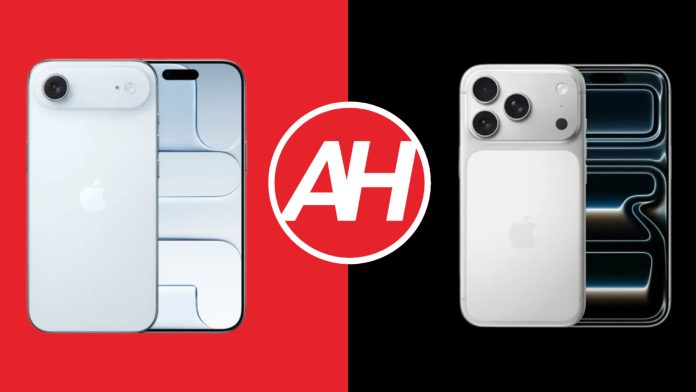Both phones that we’ll talk about in this article were announced earlier this month. They’re both a part of the iPhone 17 series of phones, kind of. The devices we’ll be comparing are the Apple iPhone Air vs Apple iPhone 17 Pro. The iPhone Air does not have a ‘17’ in its name, but it is very much a member of the iPhone 17 series. That is a newcomer in Apple’s iPhone lineup, and it’s here to replace the ‘Plus’ model.
With that being said, the iPhone Air is considerably different than the iPhone 17 Pro, especially when the design is concerned. That phone is all about thinness. It will be interesting to see how the two compare. As a reminder, we haven’t reviewed either phone at this point, this is more of a spec comparison, and to show you what each of the phones have to offer. We’ll be comparing their specs, designs, displays, performance, battery life, cameras, and audio output.
Specs

Apple iPhone Air

Apple iPhone 17 Pro
| Apple iPhone Air | Apple iPhone 17 Pro | |
|---|---|---|
| Dimensions | 156.2 x 74.7 x 5.6 mm | 150 x 71.9 x 8.8 mm |
| Weight | 165 grams | 206 grams |
| Display | 6.5-inch LTPO Super Retina XDR OLED | 6.3-inch LTPO Super Retina XDR OLED |
| Refresh rate | 1-120Hz | 1-120Hz |
| Resolution | 2736 x 1260 | 2622 x 1206 |
| Chipset | Apple A19 Pro | Apple A19 Pro |
| RAM | 12GB | 12GB |
| Storage | 256GB/512GB/1TB | 256GB/512GB/1TB |
| Main camera | 48MP (f/1.6 aperture, 1/1.56-inch sensor size, sensor-shift-OIS) | 48MP (1/1.28 aperture, 1.22um pixel size, sensor-shift OIS, dual pixel PDAF) |
| Ultra-wide camera | N/A | 48MP (f/2.2 aperture, 1/2.55-inch sensor size, 120-degree FoV, 0.7um pixel size, PDAF) |
| Telephoto camera | N/A | N/A |
| Periscope telephoto camera | N/A | 48MP (f/2.8 aperture, 1/2.55-inch sensor size, PDAF, 3D sensor-shift OIS, 4x optical zoom) |
| Selfie camera | 18MP (f/1.9 aperture, OIS) | 18MP (f/1.9 aperture, OIS) |
| Battery size | 3,149mAh | 3,988mAh (nano SIM) / 4,252mAh (eSIM only) |
| Charging | Wired, 20W MagSafe wireless, 4.5W reverse wired (charger not included) | Wired, 25W MagSafe wireless, 4.5W reverse wired (charger not included) |
| Colors | Space Black, Cloud White, Light Gold, Sky Blue | Silver, Cosmic Orange, Deep Blue |
Apple iPhone Air vs Apple iPhone 17 Pro: Design
From the front, there’s really not much difference between them. They both have flat displays, with pretty much the same corner curvature. They both include the same pill-shaped cutout, the so-called Dynamic Island. The bezels around both displays are uniform, and they’re the same in terms of thickness. The moment we start talking about anything else, however, you’ll start seeing differences.
The iPhone Air is made out of titanium and glass, while the iPhone 17 Pro is made out of aluminum and glass. The frame on the iPhone Air is considerably thinner, though it’s mostly flat on the sides, similar to what the iPhone 17 Pro offers. Both smartphones have a power/lock key on the right side, along with the Camera control key. On the left, you’ll find the volume up and down keys, along with an Action key.
Both smartphones have a flat back side. The setups are quite different, though. The iPhone Air has a pill-shaped camera bar, with a single camera. The iPhone 17 Pro has a notably larger camera bar, which includes three cameras on the inside. Cameras on both smartphones are placed in the top-left corner, though. Both of those camera bars do protrude on the back, by the way.
Both smartphones are quite slippery in the hand. The iPhone Air is a lot lighter, it’s 41 grams lighter at 165 grams. It is also taller, wider, and thinner. It does have a notably larger display, so that is to be expected in terms of height and width. Both of them are also IP68 certified for water and dust resistance.
Apple iPhone Air vs Apple iPhone 17 Pro: Display
The Apple iPhone Air features a 6.5-inch LTPO Super Retina XDR OLED display. That panel is flat, and it supports an adaptive refresh rate (1-120Hz). HDR10 is also supported, and the same goes for Dolby Vision. The peak brightness here is 3,000 nits, while the screen-to-body ratio is at around 89%. The display aspect ratio is 19.5:9, while the resolution is 2736 x 1260. This display is protected by the Ceramic Shield 2.

The Apple iPhone 17 Pro, on the other hand, has a 6.3-inch LTPO Super Retina XDR OLED display. That panel also has the same adaptive refresh rate (1-120Hz), while it also supports HDR10 and Dolby Vision. It has the same peak brightness at 3,000 nits, and its screen-to-body ratio is at around 89%. The resolution here is 2622 x 1206, while the display aspect ratio is 19.5:9. This display is also protected by the Ceramic Shield 2.
Both displays have anti-reflective coating too, and both are quite vivid. The viewing angles are good on both ends, and the blacks are also quite deep. The touch response is also good. There’s really not much to complain about here, in all honesty. Both displays are very good and not many people will have complaints here. They’re vivid, sharp, smooth, and bright.
Apple iPhone Air vs Apple iPhone 17 Pro: Performance
Both of these smartphones are fueled by the Apple A19 Pro processor, Apple’s new 3nm chip. The thing is, they’re fueled by different variants of that chip. While both chips are hexa-core processors with the same clock speeds, the one inside the iPhone 17 Pro has one extra GPU core. It comes with 6 GPU cores, while the version in the iPhone Air has 5 GPU cores. So the iPhone 17 Pro should, technically, be better for gaming. It also has superior cooling.
With that being said, both smartphones do ship with 12GB of RAM, and both of them utilize NVMe storage. Neither smartphone supports storage expansion, however. We haven’t had a chance to test them out yet, but going solely from the specs and what Apple said, there won’t be any issues. Apple’s iPhones usually perform very well day-to-day, and that will likely be the case here too. You likely won’t see any difference on a day-to-day basis between the two.
There may be some difference in the gaming department, however. They’re both more than capable enough to run demanding games, but the iPhone Air has one less GPU core, plus it doesn’t have the same cooling capacities as the iPhone 17 Pro. It will be interesting to see if the heat will be an issue.
Apple iPhone Air vs Apple iPhone 17 Pro: Battery
Despite the fact the iPhone Air is notably bigger than the iPhone 17 Pro, in terms of height and width, it has a lot smaller battery. It ships with a 3,149mAh unit, while the iPhone 17 Pro includes a 4,252mAh battery in the US (and other countries with the eSIM only model), while a 3,988mAh battery is included in the nano SIM variant. That is quite a difference, especially if you consider that the iPhone Air’s display is notably larger.
The iPhone 17 Pro will almost certainly offer notably better battery life, though we still can’t confirm that. We don’t have the exact numbers or anything just yet, but we don’t have high expectations from the iPhone Air. The good thing is that its battery is a bit larger than was rumored, though, so… we’ll see. It’s possible Apple was able to pull out respectable battery life here.
What about charging? Well, despite the fact the iPhone 17 Pro has a larger battery, it should charge faster. Apple quotes 20 minutes for a 50% charge, while the iPhone Air should take around 30 minutes to reach 50%. The iPhone Air supports 20W MagSafe wireless charging and 4.5W reverse wired charging. The iPhone 17 Pro, on the other hand, supports 25W MagSafe wireless charging and 4.5W reverse wired charging. Neither smartphone ships with a charger in the box.
Apple iPhone Air vs Apple iPhone 17 Pro: Cameras
You don’t see this as often these days, but the iPhone Air ships with a single camera on the back. That’s a tradeoff Apple opted for to keep the phone as thin and light as it is. It includes a 48-megapixel camera (1/1.56-inch sensor size), the same camera that is included in the iPhone 17 as the main camera. It is inferior to what the iPhone 17 Pro offers, but still, it should do a good job.

The iPhone 17 Pro, on the other hand, has three cameras on the back. It has a 48-megapixel main camera (1/1.28-inch sensor size), which includes a larger camera sensor than what the iPhone Air offers. That camera is backed by a 48-megapixel ultrawide snapper (1/2.55-inch sensor size, 120-degree FoV) and a 48-megapixel periscope telephoto camera (1/2.55-inch sensor size, 4x optical zoom).
While the iPhone 17 Pro has a superior camera setup, the iPhone Air should be quite capable of taking good pictures with its main camera. It will be inferior to the iPhone 17 Pro, but the differences likely won’t be huge. The same cannot be said for other cameras, though. Considering that the iPhone Air lacks both an ultrawide and a telephoto camera, the iPhone 17 Pro will do a much better job with zoom shots, while it’s also the only one here that has the option to take ultrawide shots. It will also be superior when it comes to macro photography.
Audio
The Apple iPhone Air does not have stereo speakers. The phone has a single speaker, which is another tradeoff Apple opted for to keep it that thin. The iPhone 17 Pro does include stereo speakers and will offer better sound output.
Neither of these two smartphones ships with an audio jack. They do include a Type-C charging port, though, which can be used to connect wired headphones. You’ll need a dongle, though. Both smartphones also include Bluetooth 6.0 for wireless audio.
#Apple #iPhone #Air #Apple #iPhone #Pro

